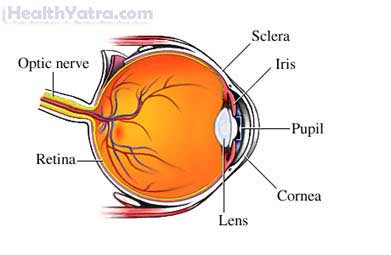Definition
Astigmatism is a condition where vision is disordered (blurred, unfocused, fuzzy) because the cornea (the front surface of the eye) or lens, which is located behind the cornea, has an abnormal or irregular curve (misshaped). Astigmatism can occur in children as well as adults. Astigmatism is fairly common and not contagious.
There are two common types of astigmatism: corneal astigmatism and lenticular astigmatism.
- Corneal astigmatism is when the cornea is misshaped.
- Lenticular astigmatism is when the lens is misshaped.
There are several treatment options for astigmatism. If you suspect you have astigmatism, contact your doctor.

Causes
The precise cause of astigmatism is unknown. It is often present at birth and may coexist with nearsightedness or farsightedness. Sometimes it may occur after an injury or eye surgery.
Risk Factors
A risk factor is something that increases your chance of getting a disease or condition.
The following factors increase your chances of developing astigmatism. If you have any of these risk factors, tell your doctor:
- Heredity—a family history of eye disease or disorders, such as keratoconus
- Eye surgery—certain types of eye surgery, such as cataract (lens of the eyes are cloudy) removal (less common with modern techniques)
- A history of corneal scarring or thinning
- A history of excessive nearsightedness (a visual defect where distant objects appear blurred) or farsightedness (a visual defect where distant objects are seen better than objects that are close)
Symptoms
The symptoms for astigmatism vary from person-to-person. Some people might be asymptomatic (showing no signs of the condition) while others are symptomatic (showing signs of the condition). If you experience any of these symptoms, do not assume it is due to astigmatism. These symptoms may be caused by other, less serious health conditions. If you experience any one of them, see your physician.
- Dizziness
- Headaches
- Blurred (objects appear fuzzy) or distorted (objects appear twisted or out of focus) vision
- Excessive squinting or closing of the eyes
Diagnosis
Your doctor will ask about your symptoms and medical history, and perform a physical exam. You may also be referred to a doctor who specializes in the medical and surgical treatment of eye disorders and vision measurements (ophthalmologists) or a trained and licensed professional who can diagnosis vision and eye disease and prescribe corrective lenses (optometrist). Tests may include the following:
- Visual acuity assessment test (VAT)—this test is used to measure how well you can distinguish different size letters or symbols (very large to very small) at a specific distance
- Refractor test—this test uses a refractor, a special instrument that has interchangeable lenses of different strengths to measure how well you see objects at various distances. The ophthalmologist or optometrist will ask you to look through the lens and read a chart that is several feet away. The ophthalmologist or optometrist will adjust the strength of the lens based on your responses.
- Keratoscope—a device used to detect and measure the presence of corneal surface curvature
Treatment
Talk with your doctor about the best treatment plan for you. Treatment options include the following:
Corrective Lenses
Corrective lenses, such as glasses or toric contact lens, are prescribed to offset the eye’s visual abnormalities or defects, such as excessive nearsightedness, farsightedness, or astigmatism.
Surgery
To correct severe astigmatism, an ophthalmologist might use special knives or a laser beam to correct the abnormal or irregular curve of the cornea. The surgery is an outpatient procedure (does not require a hospital stay) that is performed with local anesthesia.
There are three types of surgical procedures that an ophthalmologist might perform:
- Photorefractive keratectomy (PRK)—Laser beams are used to reshape the abnormal or irregular curve of the cornea.
- Laser in situ Keratomileusis (LASIK)—This is a type of PRK; the ophthalmologist uses a laser beam to reshape the curve of the cornea by removing corneal tissue.
- Radical keratotomy (RK)—Small incisions (cuts) are made partial thickness into the cornea.
- Laser-assisted subepithelial Keratomileusis (LASEK)—This procedure is not as commonly used; however, it may offer additional benefits especially for patients with thin corneas or at high risk of an eye injury.
There are risk factors associated with all surgery. To choose the best surgical treatment option for your condition, it is important that you speak with your doctor about potential risks and side effects.
Prevention
There are no known preventative measures that will reduce your chances of getting astigmatism. However, routinely getting a comprehensive vision exam will reduce your chances of astigmatism going undetected (unidentified) and untreated.
Astigmatism Treatment in India – Page Keywords:
Astigmatism Definition, Astigmatism Definition Causes, Astigmatism Symptoms, Astigmatism Treatment in India, Astigmatism Treatment Cost in India, Astigmatism Surgery Cost, Top Astigmatism Treatment Hospital, Top Astigmatism Treatment Doctor in India, Astigmatism Meaning in Marathi, Astigmatism Treatment Near me, Astigmatism Complications, Travel India for Astigmatism Treatment, Astigmatism Treatment in Arab Countries, Astigmatism Treatment in Bangladesh, Astigmatism Treatment in Dhaka, Astigmatism Meaning in Bengali, Astigmatism Meaning in Arabic, Astigmatism Meaning in Hindi, Astigmatism Treatment in Bahrain, Astigmatism Treatment in Egypt, Astigmatism Treatment in Iraq, Astigmatism Treatment in Jordan, Astigmatism Treatment in Kuwait, Astigmatism Treatment in Lebanon, Astigmatism Treatment in Saudi Arabia, Astigmatism Treatment in United Arab Emirates, Astigmatism Treatment in Sudan, Astigmatism Treatment in Tunisia, Astigmatism Treatment in Nepal, Astigmatism Treatment cost,
